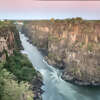 Beginning at the truly awe-inspiring Victoria Falls, travel through Zimbabwe, Zambia, Malawi and Tanzania and experience all the incredible sights, sounds and cultures this pocket of Africa has to offer. Not to mention incredible opportunities to view wildlife. Spot lions, leopards and if you’re lucky, rare black rhinos, on game drives through Matobo National Park and Mikumi National Park. Explore World Heritage sites, like the Great Zimbabwe Ruins, swim and snorkel in the clear freshwaters of Lake Malawi, and meet locals and get insight into local culture. This epic adventure is sure to provide memories that will last a lifetime.
Beginning at the truly awe-inspiring Victoria Falls, travel through Zimbabwe, Zambia, Malawi and Tanzania and experience all the incredible sights, sounds and cultures this pocket of Africa has to offer. Not to mention incredible opportunities to view wildlife. Spot lions, leopards and if you’re lucky, rare black rhinos, on game drives through Matobo National Park and Mikumi National Park. Explore World Heritage sites, like the Great Zimbabwe Ruins, swim and snorkel in the clear freshwaters of Lake Malawi, and meet locals and get insight into local culture. This epic adventure is sure to provide memories that will last a lifetime.Highlights
Experience the rumble and roar of Victoria Falls from the Zimbabwe side, which gives you the broadest view.
Visit the Victoria Falls Wildlife Trust to learn about the rehabilitation of wildlife from conflict and poaching and have the possibility of meeting some rescued or orphaned wildlife currently in their care.
Discover the magic of South Luangwa National Park, a highly concentrated arena of noble beasts and exotic wildflowers, on a morning game drive.
Explore the largest ruins in sub-Saharan Africa, the World Heritage-listed Great Zimbabwe.
Get a taste of the colourful cities of the region, with time in Lusaka, Harare and Bulawayo.
Accompanied by a local crew — a leader, driver and cook – you'll be in excellent hands for the duration of your adventure.






- You will visit the following places:
-

Selborne Park
Bulawayo is the second-largest city in Zimbabwe after the capital Harare. Located in Matabeleland, colloquially the city is also known by various names, these being the 'City of Kings', 'Skies', 'Bluez', 'Bulliesberg' or 'KoNtuthu ziyathunqa' – a isiNdebele phrase for "a place that continually exudes smoke". This name arose from the city's historically large industrial base. The majority of the Bulawayo's population belongs to the Ndebele ethnic and language group. For a long time in Zimbabwe's history Bulawayo was regarded as the industrial centre of Zimbabwe and the city served as the hub to the country's rail network with the National Railways of Zimbabwe headquartered there because of its strategic position near Botswana and South Africa. It is the nearest large city to Hwange National Park, Matobo National Park and Victoria Falls.
-

Harare
Harare (officially called Salisbury until 1982) is the capital and most populous city of Zimbabwe. Situated in the north-east of the country in the heart of historic Mashonaland, the city. The city was founded in 1890 by the Pioneer Column, a small military force in the service of the British South Africa Company, and named Fort Salisbury after the British Prime Minister Lord Salisbury. Salisbury was thereafter the seat of the Southern Rhodesian (later Rhodesian) government and, between 1953 and 1963, the capital of the Central African Federation. It retained the name Salisbury until 1982, when it was renamed Harare on the second anniversary of Zimbabwean independence. Harare is Zimbabwe's leading financial, commercial, and communications centre, and a trade centre for tobacco, maize, cotton, and citrus fruits. Manufactured goods include textiles, steel and chemicals, and gold is mined in the area. The city's suburbs include Borrowdale, Mount Pleasant and Avondale; the most affluent neighbourhoods are to the north. The University of Zimbabwe, the country's oldest university (founded in 1952), is situated in Mount Pleasant, about 6 km (3.7 mi) north of the city centre. Harare is home to the country's main Test cricket ground, Harare Sports Club, and to Dynamos F.C., Zimbabwe's most successful association football team.
-

Dar es Salaam
Dar es Salaam, a major city and commercial port on Tanzania’s Indian Ocean coast, grew from a fishing village. It was founded in 1862 by Sultan Seyyid Majid of Zanzibar on the site of the village of Mzizima. With its great atmosphere, mix of African, Muslim, and South Asian influences, picturesque harbour, beaches, chaotic markets, and historic buildings, it is well worth extending your stay beyond the time between flights. Present day Dar es Salaam's origins have been influenced by a myriad of sultans, the Germans and the British. The city started as a fishing village in the mid 19th century, is now Tanzania's largest city, and has become one of East Africa’s most important ports and trading centers.